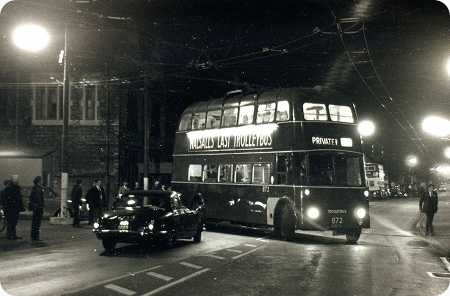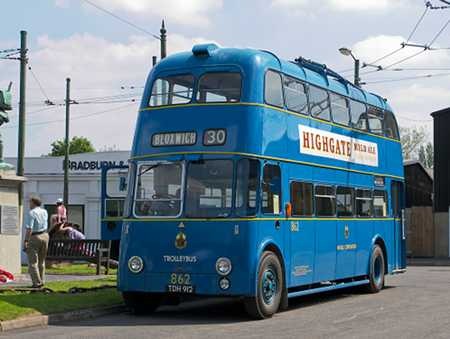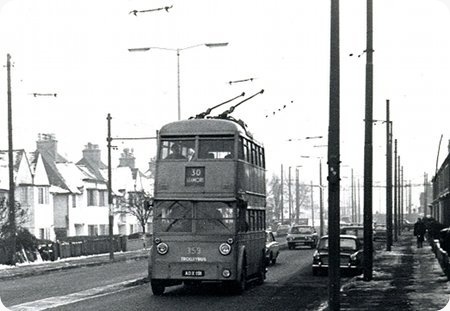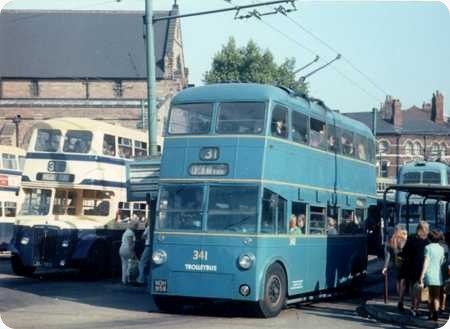
Copyright Tony Martin
Walsall Corporation
1956
Sunbeam F4A
Willowbrook H36/34R
Walsall Sunbeam F4A, Willowbrook bodied trolleybus, 872 XDH 72.
Seen leaving Bichills Depot on the evening of 3rd October 1970, having dropped off the guests it carried and is now making the last run ‘under the wires’ on a public road by a Walsall trolleybus.
At the wheel is Mr R. Edgley Cox, Walsall’s well known general manager.
The bus had been owned by West Midlands PTE since October 1969 and is now at Sandtoft Trolleybus Museum.
Photograph and Copy contributed by Tony Martin
13/11/12 – 17:30
How very atmospheric! Thanks for sharing.
Pete Davies
13/11/12 – 17:31

Here is a picture of fellow Walsall Corporation Sunbeam/Willowbrook trolleybus No. 862, which now resides at the Black Country Museum, Dudley, where I photographed it on 3 June 2010.
Roger Cox
14/11/12 – 07:31
Distinctive, if not that attractive vehicle, IMHO. I do recall being surprised at seeing one of these running around Portsmouth, when there was a municipal transport conference on at the Guildhall around 1955-56. It certainly turned some heads, with its blue livery amongst the familiar maroon/white natives!
Chris Hebbron
14/11/12 – 07:31
Although these vehicles were something of an ‘ugly duckling’ there was something charismatic about them and I always liked them. I have often wondered how long Walsall would have continued to run trolleybuses if the West Midlands PTE had not been set up. Having taken over in 1969 the PTE couldn’t wait to be rid of the trolleys and the drafting in to Walsall of large numbers of Birmingham ‘standards’ hastened the conversion. If my memory serves me correctly this left just Teesside and Bradford still operating trolleybuses and I was present at the last day for both these systems.
Philip Halstead
15/11/12 – 11:12
I’ve always thought that Mr Cox, if he had the chance, would have made sure Walsall’s trolleybuses were the last, even if only by an hour! Of course, early 1972 was one of the periods when power cuts affected many parts of the country.
More of my ‘old bus’ photos on www.flickr.com
Tony Martin
17/04/13 – 07:20
I have a photo somewhere of 864 running route 20 Eastney in Portsmouth – I’ll look to uploading it soon.
If only Walsall had retained the wiring on one of the circular routes and one each of the vehicles…
jvs
05/06/13 – 05:51
Almost certain Ron Edgley-Cox is sat on the contactor cabinet in this shot – but he was most certainly at the wheel when it came back
jvs
12/07/13 – 07:56
As mentioned the N/S cab contains the large contact box and keeps it well protected. These were the first 30ft trolleybuses to be placed in service on two axles and weighed in at I think, 7 Ton 5 cwt. 832 is a nice one to drive and very user friendly.
William Parker
15/07/13 – 08:14
It was perhaps surprising that Mr Edgley Cox opted for this design since in May 1954 he sent a drawing to the Ministry of Transport for a longer 62 seat version of Hulls Coronation trolleybuses. He fully supported G H Pulfrey’s views on one-man operation and saw this as a good design although his version lacked a central staircase despite having a central doorway as well as the forward doorway.
He also advocated longer single deck trolleybuses.
Malcolm J Wells
11/09/13 – 16:30
Great night picture. I passed out for my green badge on Walsall’s trolley buses (Was it Mr Clarke) and was so sorry to see them go. The colour of those buses at night was strange due to the street lighting. Frosty early mornings was like bonfire night sparks and flashes lighting up the streets. That bamboo pole was in regular use with me pulling the wrong change over, Great buses indeed yes I loved those trolleys. That vehicle they used to come and repair and tape up the damaged poles was an oddity lol. Happy days. I must go to the BCM to see one again. The Daimler Fleetline’s was a lot slower, shhhh, early morning Pratt’s bridge/Walsall you could get a lick on. Thanks for the chance to see those pics, lovely site.
Frank
14/02/14 – 13:29
Edgley Cox tried to get towards one man operation when he converted three trolley buses from rear entrance to front entrance. They were 875, 876, 877, These were the first buses I worked on when I started a an apprentice bodybuilder in 1961.
Stewart Poxon
16/02/14 – 07:53
There was a rumor that Walsall purchased Bournemouth 300 in 1969, for some sort of electric to diesel conversion experiments. Did this happen or was 300 scrapped like the rest?
Lewis Esposito
04/04/14 – 06:22
Walsall did have Bournemouth 300 (300 LJ) at their works in 1969, the plan being to make modifications so that it would be suitable for OMO. The plan was to buy 29 of these modern trolleybuses from Bournemouth at a total price of £4,000. One report says that the electric motors were to be removed and replaced by diesel engines. For more search Flickr "300LJ" and you’ll see my copies of newspaper articles from 1969 about this project.
Walsall1955
06/04/14 – 08:22
According to David Harvey’s book on Walsall no. 300 was fitted with a diesel engine under the rear staircase in order to be able to operate away from the overhead – the front entrance was to be widened and the rear platform and staircase removed . Extra trolleybuses were wanted for five additional routes under the terms of a Parliamentary Bill of 1969. I am very pro-trolleybus but why, with the impending PTE takeover, trolleybus expenditure was being pursued at this late date is an interesting question.
Ex Cleethorpes 873 was also subject to engine fitting experiments.
Malcolm Wells
06/04/14 – 10:41
Thx for the additional info, Malcolm. This would explain the hole cut in the offside rear of said trolleybus, which had puzzled me up until now. Here is the link to 300LJ which Walsal1955 mentioned above: www.flickr.com/photos/walsall1955
Chris Hebbron
11/10/14 – 06:01
Walsall 862 at the BCLM – www.youtube.com/watch?v
William Parker




